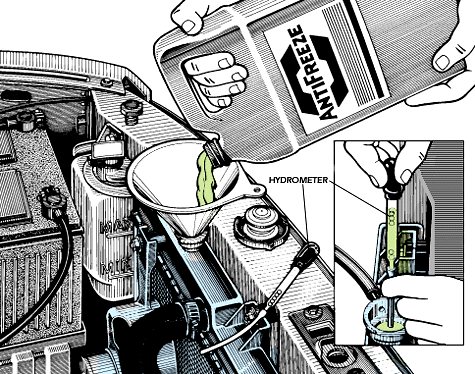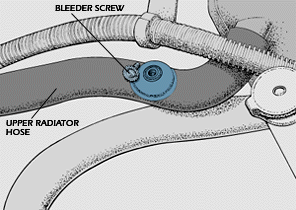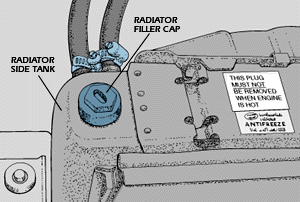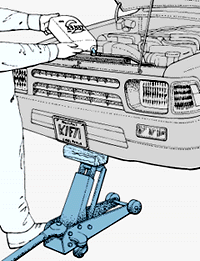|
|
|
ANTIFREEZE Choosing The Right Coolant By Paul Weissler
March 1, 1999
You've got the hood up for the
first underhood check in a while, which isn't surprising in this era of
self-service gas. Checking the coolant level, you see that it's down.
You don't carry a jug of antifreeze with you, so instead of doing
anything, you just worry about it until you get home. Actually, you
realize that it's finally time to change the whole system, not just top
up.
At least the auto parts store is on the way home, all the better to pick up a couple of jugs of antifreeze. But what kind? The parts store now stocks three colors: yellow, green and orange. Huh? Isn't all antifreeze green? Isn't it all the same? Bad News, Good News The bad news is that it doesn't come down to color matching. Isn't all antifreeze compatible? Sorry, but it isn't. There are a few cases where you can get a fast case of corrosion, some where the water pump can be both eroded and corroded to an early death, and a lot of cases where you can shorten the effective life of the antifreeze. Antifreeze itself (most commonly a chemical called ethylene glycol) doesn't wear out–ever–but the key ingredients are the rust and corrosion inhibitors, and they get used up. The most common inhibitors, silicates for aluminum protection, are used up faster than others. That's why some new cars (all General Motors, Mercury Cougar, VW/Audi models) have red or orange antifreeze with a new class of inhibitors, called organic acids. Examples of U.S. brands with these organic acids: Havoline Dex-Cool and Prestone Extended Life, both recommended for five years or 150,000 miles. That's the good news. Fill 'Er Up How about just pouring orange antifreeze into every cooling system, say, yours? Sorry, but it's not that simple. The new organic acid antifreezes may be used only if the cooling system has an aluminum radiator (rather than copper-and-brass). However, let's assume the reason you're thinking of a coolant change is because you're changing a cooling system part (pump, radiator, heater, thermostat housing) on a system with a conventional coolant, not an organic acid orange or pink. In that case, don't change to organic acid orange, even if the part you're installing is aluminum. Use a fresh fill of familiar U.S. yellow/gold or green silicated antifreeze. The two orange extended-life antifreezes are compatible with each other, with what's factory-fill in GM ca rs and the '99 Mercury Cougar, and with the pink in VW/Audi cars. However, they're not compatible with a special orange antifreeze in 1998-99 Chrysler L/H cars (Dodge Intrepid/Chrysler Concorde and 300M), a special "hybrid" mix of organic acids and silicates. The green in most Japanese cars contains no silicates, so it's not the same as the green in the parts store. The yellow in some European cars contains some silicates, but it's very different from yellow Prestone, the top-selling U.S. brand. And then there is red antifreeze used by Toyota, and blue used on some European and Korean cars. Freshen Up That Cup For You, Sir? What about just topping up a system that's low? What kind should you use? If the system (except for Chrysler L/H) has orange or pink, use Prestone or Havoline orange for top-up. All you have on hand is regular U.S. yellow/gold or green? Well, if you're desperate, use what you've got, because it's better than running low o n coolant and possibly overheating. But the mixture is shortening the life of the antifreeze. By how much? It would take lab tests to tell, so the best deal is to do the equivalent of a "retrofit." Can you retrofit all systems? Sorry, the answer is no. What about draining green or yellow/gold from the radiator and refilling with orange? Is that considered a "retrofit"? No, and you'd better not try that, either. What if the system has Japanese green, Toyota red, Korean or European blue, or European yellow? As we noted, European and Korean formulas have silicates, so U.S. green or yellow/gold is all right, but it slightly compromises the extended life formulas some have. Typically all that means is: Change at 30,000 instead of 36,000 miles. The Japanese green and red antifreezes have no silicates, but they are very different from U.S. orange. If you really drain out the old antifreeze from any of these systems (thoroughly rinse the system with fresh water), you certainly can refill with a U.S. yellow/gold or green silicated antifreeze.  Refill the system to half its capacity with coolant. Then add water to fill, achieving a 50 percent concentration of coolant. Check the concentration with a hydrometer.  This Thexton drain plug/petcock socket may help remove stubborn plugs.  Some systems use a bleeder screw in the upper radiator hose. Remove it while refilling until the liquid bubbles out. Now let's look at "retrofit" and "drain and fill" and explain what you can and can't do safely, and a bit of why. If a vehicle has a copper-and-brass radiator, forget a retrofit, says General Motors, because the organic acid (orange) antifreeze may not provide adequate protection for the lead solder in that radiator. The Chrysler orange hybrid combination of silicates and organic acids is meant to provide special protection for the water pump. Sorry, you can buy it only at a Chrysler-brand dealer. Prestone believes you can retrofit to its organic acid orange almost any vehicle with an aluminum radiator and cooling system that has been well-maintained and is in good condition, if you do it right. H owever, the antifreeze maker recognizes the possibility of a problem with Dodge truck 5.9-liter V8 water pumps, for which green or yellow/gold U.S. antifreeze is recommended–if you don't get Chrysler's specific orange. Filling The System The idea in any case is to rinse your cooling system well, until the liquid is clear water. The radiator may hold less than a third of the coolant. The radiator may have an air bleed or plug on top of the tank or the side, and if it does, open or remove it. Next, open the drain cock. Collect the coolant in a pan. Next, disconnect the lower radiator hose from the radiator and let coolant drain from the block. Third, disconnect the hoses from the heater core, attach auxiliary hoses to the core necks and force a garden hose nozzle into one hose. Run plain water through that hose until clear water comes out the other. If there are coolant hoses connected to the intake manifold or throttle body, disconnect them at the other ends, and allow the part to drain. Finally, empty the overflow reservoir into the catch pan. Measure the coolant drained from the radiator, engine, manifold or throttle body and reservoir. If you've collected at least 90 percent of the cooling system capacity, and the coolant now is clear, you're ready. If it still has some antifreeze dye color, slowly fill the system with plain water, with all air bleeds open. Dispose of the coolant in an environmentally responsible manner, please. Call your local fire department for advice. As water oozes from an air bleed, close it, then keep filling. When you've filled the system, top up the reservoir and run the engine until it's warmed up. Turn on the heater to be sure the heater core is flushed. Let the engine cool, drain the radiator and if the coolant is clean and clear, you're ready to fill. Disconnect the lower radiator hose and let the water drain from the engine too, so that the drained amount is at least half the capacity of the system. Also, draining the reservoir should give you a margin. Add an amount of your choice of antifreeze yellow/gold, green or a "retrofit" to orange–equal to any percentage between 50 percent and 60 percent, and then top up with water. Take It Higher Always fill a system with the front of the car jacked up as high as possible, and all the air bleeds open. When coolant oozes from an air bleed, close it and continue filling. Air rises to the top and the jacked-up front will help purge air pockets in the system. Fill slowly to allow trapped air to escape. Complete filling of a system can take lots of "thermo-cycling"–warming up the engine and letting it cool down–to purge all the air pockets, and, in fact, you may have to recheck the system over a period of a week or more of operation. Some systems are so difficult the factories provide very specific procedures, so check a factory service manual before you begin. It could save you lots of time and effort.  One bleeder bolts may appear in the cylinder head or, in this case, on top of the thermostat housing.  This radiator filler cap is intended to be used only for refilling the system, not topping up. Otherwise, don't even loosen it.  Jack the front of the car as high as possible to prevent air bubbles from forming in the cooling system. |